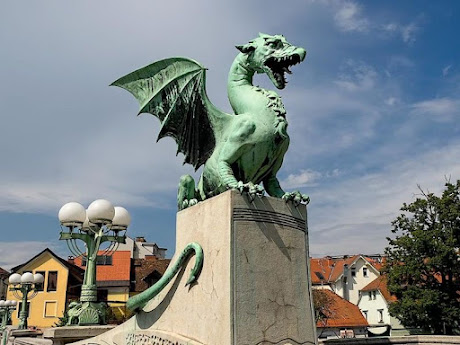“Puff, the Magic Dragon, lived by the sea, and frolicked in the Autumn Mist in a land called Honah Lee; little Jacky Paper loved that rascal Puff, and gave him strings and sealing wax and other fancy stuff.”
― Peter Yarrow, Puff the Magic Dragon lyrics===================================================================
(in central Slovenia) Ljubljana, this country's capital and largest city, is one of Europe's greenest and most liveable capitals. In summer, cafes set up terrace seating along the river, making it feel a bit like a nightly street party. Now also the economic, political, and cultural center of Slovenia, Ljubljana was once a walled Roman encampment, built here in the mid-1st century BCE by Roman legionnaires; it then developed into the settlement of Emona (Iulia Aemona), though the area had been settled earlier by the Veneti, the Illyrians, and the Celts, beginning about 1000 BCE. Sitting on the route to Pannonia and commanding the Ljubljana Gap, the strategically located city was destroyed by Attila (the Hun) in the mid-5th century. The Slovene Slavic tribes, migrating westward, rebuilt it in the 12th century, when its name was first recorded as Laibach (in 1144) and then as Luvigana (1146). It gained city rights in 1220.
+ In the late 13th century, rule passed to the Habsburgs, and in 1335 Ljubljana became the capital of the Habsburg-Austrian province of Carniola. From 1461 Ljubljana was the seat of a bishop. Taken by the French in 1809, it became the government seat of the Illyrian Provinces.
+ Foreign rule ended in 1918, when Ljubljana and Slovenia became part of the Kingdom of Serbs, Croats, and Slovenes (later Yugoslavia). In 1991, when Slovenia gained its independence, Ljubljana became its national capital.
+ Ljubljana is dominated by a medieval fortress, which dates from the 12th century. The old quarter of the city lies between the fortress and the river. Only a few old buildings of the Austrian Baroque style survived a violent earthquake in 1895. The subsequent rebuilding of the city, particularly those buildings designed by the Art Nouveau architect Josef Plečnik, gave Ljubljana a modern appearance. The city also received a grid pattern. Fine stone bridges, such as the Tromostovje (Triple Bridge), were constructed across the river.
+ A popular local attraction is the Tivoli Park, which was built in the 19th century. The city’s leading educational institution is the University of Ljubljana. the National and University Library, the Joef Stefan Institute (a public research institute), and the Slovene Academy of Sciences and Arts are also located in the city. A philharmonic, among the first outside Italy, was established in 1701, The city’s finer museums and galleries include the National Museum of Slovenia, the Slovenian Museum of Natural History, the National Gallery, and the Gallery of Modern Arts. Other attractions include a botanical garden and a zoo.
+ Four large dragons guard Ljubljana's Dragon Bridge (Zmajski most), symbol of Ljubljana), with two at each end:





No comments:
Post a Comment